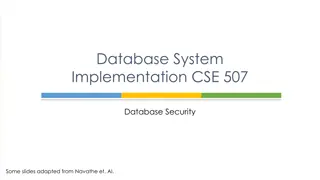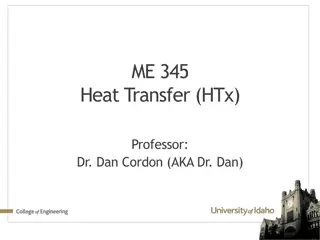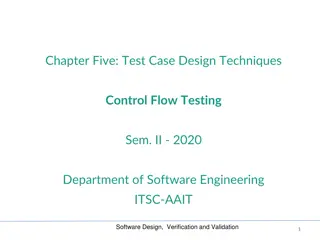Understanding Exceptional Control Flow in Computer Systems
Control flow mechanisms in computer systems have evolved to handle exceptional events triggered by external system states. This includes exceptions, interrupts, and context switches that enable the CPU to respond to events like data arrival, user inputs, and system timeouts. Exception handling involves transferring control to the operating system, changing the mode from user to kernel, and executing predefined handlers for specific event types. Interrupt vectors map these events to corresponding exception handlers, allowing for asynchronous handling of external events through interrupts.
Download Presentation

Please find below an Image/Link to download the presentation.
The content on the website is provided AS IS for your information and personal use only. It may not be sold, licensed, or shared on other websites without obtaining consent from the author. Download presentation by click this link. If you encounter any issues during the download, it is possible that the publisher has removed the file from their server.
E N D
Presentation Transcript
Control Flow Up to Now: two mechanisms for changing control flow: Jumps/branches Call and return using the stack Both react to changes in internal program state. Insufficient for a useful system Need CPU to react to changes in external system state as well! data arrives from a disk or a network adapter. User hits Ctrl-c at the keyboard System timer expires Instruction divides by zero Need mechanisms for exceptional control flow 2
Exceptional Control Flow Change in control flow in response to a system event Low level Mechanisms 1. Exceptions and interrupts Higher Level Mechanisms 2. Process context switch 3. Signals 4. Nonlocal jumps (setjmp/longjmp) 3
System context for exceptions Keyboard Mouse Modem Printer Interrupt controller Keyboard controller Serial port controller Parallel port controller Processor Local/IO Bus Video adapter Network adapter IDE disk controller SCSI controller Memory SCSI bus Network Display disk disk CDROM 5
Exceptions and interrupts Transfer of control to the OS in response to some event Require mode change from user to kernel/supervisor External events: I/O request completes, typing Ctrl-C Exceptional program execution events: Divide by 0, page fault User code Kernel code Exception Event I_current I_next Exception processing by exception handler Return to I_current Return to I_next Abort 6
Interrupt Vectors Many types of interrupts and exceptions Each type of event has a unique exception number k Index into jump table in OS (a.k.a., interrupt vector table) Jump table entry k points to a function (exception handler). Handler k is called each time exception k occurs. code for handler 0 interrupt vector Exception numbers code for handler 1 0 1 2 code for handler 2 ... ... n-1 code for handler n-1 IDTR (Interrupt Descriptor Table Register) 7
Asynchronous Exceptions (Interrupts) Caused by events external to the processor Indicated by setting the processor s interrupt pin Causes a handler to run Handler returns to next instruction when finished Examples: Timer interrupt Every few ms, an external timer triggers an interrupt Used by the kernel to take back control from user programs I/O interrupts hitting Ctrl-c at the keyboard arrival of a packet from a network arrival of a data sector from a disk 8
Synchronous Exceptions Caused by events that occur as a result of executing an instruction: Traps (intentional exceptions) Examples: system calls, breakpoint traps, special instructions Returns control to next instruction Faults (unintentional exceptions) Potentially recoverable Examples: page faults (recoverable), protection faults (unrecoverable). Either re-executes faulting ( current ) instruction or aborts. Aborts Unintentional and unrecoverable Examples: parity error, machine check. Aborts current program 9
Examples of x86-64 Exceptions Exception Number 0 13 Description Divide by zero General protection fault Page fault Machine check System call OS-defined exceptions Exception Class Fault Fault 14 18 128 32-255 Fault Abort Trap Interrupt or trap 10
Trap example: System Call Trap into OS (kernel) Implemented via int 0x80 or syscall instruction Each x86-64 system call has a unique ID number that is passed in %rax Number 0 1 2 3 4 57 59 60 62 Name read write open close stat fork execve _exit kill Description Read file Write file Open file Close file Get info about file Create process Execute a program Terminate process Send signal to process 11
System Call example Opening a File User calls: open(filename, options) Calls __open function, which invokes system call instruction syscall Function __open executes system call instruction 00000000000e5d70 <__open>: ... e5d79: b8 02 00 00 00 e5d7e: 0f 05 e5d80: 48 3d 01 f0 ff ff ... e5dfa: c3 retq mov $0x2,%eax # open is syscall #2 syscall # Return value in %rax cmp $0xfffffffffffff001,%rax %rax contains syscall number Arguments in %rdi, %rsi, %rdx, %r10, %r8, %r9 Negative value is an error corresponding to negative errno OS opens file and gets it ready for reading or writing Returns integer file descriptor 12
System Call Example: Opening File 00000000000e5d70 <__open>: ... e5d79: b8 02 00 00 00 e5d7e: 0f 05 e5d80: 48 3d 01 f0 ff ff ... e5dfa: c3 retq mov $0x2,%eax # open is syscall #2 syscall # Return value in %rax cmp $0xfffffffffffff001,%rax User code Kernel code Exception syscall cmp Open file Returns 13
Fault Example: Page fault example int a[1000]; main () { a[500] = 13; } Memory Reference User writes to memory location That portion (page) of user s memory is currently on disk 80483b7: c7 05 10 9d 04 08 0d movl $0xd,0x8049d10 OS page handler must load page into physical memory Returns to faulting instruction Successful on second try User code Kernel code Exception: page fault movl Copy page from disk to memory Return and reexecute movl 14
Fault Example: Segmentation fault int a[1000]; main(){ a[5000] = 13; } Memory Reference User writes to memory location Address is not valid 80483b7: c7 05 60 e3 04 08 0d movl $0xd,0x804e360 OS page handler detects invalid address Sends SIGSEGV signal to user process User process exits with segmentation fault User code Kernel code Exception: page fault movl Detect invalid address Signal process 15
Exceptional Control Flow Change in control flow in response to a system event Low level Mechanisms 1. Exceptions and interrupts Higher Level Mechanisms 2. Process context switch 3. Signals 4. Nonlocal jumps (setjmp/longjmp) 16
Recall Processes A process is an instance of a running program. Process provides each program with two key abstractions: Logical control flow Each program seems to have exclusive use of the CPU Private address space Each program seems to have exclusive use of main memory. Memory Stack How are these Illusions maintained? Process executions interleaved (multitasking) Address spaces managed by virtual memory system Heap Data Code Exceptions instrumental for process management CPU Registers 17
Multiprocessing: The Illusion Memory Memory Memory Stack Stack Stack Heap Data Heap Data Heap Data Code Code Code CPU CPU CPU Registers Registers Registers CPU runs many processes Applications and background tasks CPU runs one process at a time, but it appears to user(s) as if all processes executing simultaneously How? Processes continually switch When process needs I/O resource or timer event occurs 18
Context Switching mechanism Processes are managed by the operating system kernel Important: the kernel is not a separate process, but rather runs as part of some existing process Control flow passes from one process to another via a context switch. Process A Process B user code context switch kernel code Time user code context switch kernel code user code 19
Context switching Memory Stack Stack Stack Heap Data Heap Data Heap Data Code Code Code Saved registers Saved registers Saved registers CPU Registers Single processor executes multiple processes Process executions interleaved (multitasking) Address spaces managed by virtual memory system (later) Register values for nonexecuting processes saved in memory (usually) 20
Context switching Memory Stack Stack Stack Heap Data Heap Data Heap Data Code Code Code Saved registers Saved registers Saved registers CPU Registers Save current registers in memory 21
Context switching Memory Stack Stack Stack Heap Data Heap Data Heap Data Code Code Code Saved registers Saved registers Saved registers CPU Registers Schedule next process for execution 22
Context switching Memory Stack Stack Stack Heap Data Heap Data Heap Data Code Code Code Saved registers Saved registers Saved registers CPU Registers Load saved registers and switch address space (context switch) 23
Multiprocessors Memory Stack Stack Stack Heap Data Heap Data Heap Data Code Code Code Saved registers Saved registers Saved registers CPU CPU Multicore processors Multiple CPUs on single chip Share main memory (and some of the caches) Each executes a separate process Scheduling of processors onto cores done by kernel Registers Registers 24
Example Tasks: 254 total, 1 running, 253 sleeping, 0 stopped, 0 zombie %Cpu(s): 1.7 us, 1.6 sy, 0.0 ni, 96.4 id, 0.3 wa, 0.0 hi, 0.0 si, 0.0 st KiB Mem: 32890072 total, 32204380 used, 685692 free, 782968 buffers KiB Swap: 33459196 total, 23372 used, 33435824 free. 14354472 cached Mem PID USER PR NI VIRT RES SHR S %CPU %MEM TIME+ COMMAND 2375 wuchang 20 0 3175820 914904 864160 S 5.0 2.8 1601:26 VirtualBox 8994 wuchang 20 0 1425804 126280 56668 S 4.6 0.4 0:07.72 chrome 9035 wuchang 20 0 449308 64872 38552 S 3.0 0.2 0:02.72 chrome 25310 root 20 0 320724 119724 38060 S 2.3 0.4 127:30.36 Xorg 9121 wuchang 20 0 903836 183412 26108 S 1.7 0.6 0:08.28 chrome 25783 wuchang 20 0 653192 31364 14136 S 1.0 0.1 6:23.03 gnome-term+ Running program top or ps auxw System has 254 processes Identified by Process ID (PID) 25
Terminating Processes Process terminates for one of three reasons: Receiving a signal whose default action is to terminate Returning from the main routine or directly calling the exit function void exit(int status) Terminates with an exit status of status Convention: normal return status is 0, nonzero on error Another way to explicitly set the exit status is to return an integer value from the main routine exit is called once but never returns. 27
Creating Processes Parent process creates a new running child process by calling fork int fork(void) Child is identical to parent, except Call returns child s process ID (PID) to parent process Call returns 0 to the child process, fork is interesting (and often confusing) because it is called once but returns twice 28
Fork Up until now, sequential execution in single program Most modern applications employ concurrency Fork provides coarse, process-level concurrency Identical, but separate address spaces Only difference is return value from fork call different Child gets identical copies of the parent s open file descriptors (stdout same in both parent and child) Variable x has a value of 1 when fork returns in both parent and child Subsequent changes to x are independent Can t predict execution order of parent and child 29
if (fork() == 0) { printf("hello from child\n"); } else { printf("hello from parent\n"); } What about errors? 30
System Call Error Handling On error, Unix system-level functions typically return -1 and set global variable errno to indicate cause. Return status should be checked after every system-level function Example: if ((pid = fork()) < 0) { fprintf(stderr, "fork error: %s\n", strerror(errno)); exit(0); } 31
Error-handling wrappers Can be simplified using wrappers: pid = Fork(); pid_t Fork(void) { pid_t pid; if ((pid = fork()) < 0) unix_error("Fork error"); return pid; } void unix_error(char *msg) /* Unix-style error */ { fprintf(stderr, "%s: %s\n", msg, strerror(errno)); exit(0); } 32
Fork Example #1 void fork1() { int x = 1; pid_t pid = fork(); if (pid == 0) { printf("Child has x = %d\n", ++x); } else { printf("Parent has x = %d\n", --x); } printf( PID %d with x = %d\n", getpid(), x); } Parent has x = 0 PID 23223 with x = 0 Child has x = 2 PID 23224 with x = 2 #include <sys/types.h> #include <unistd.h> pid_t getpid(void); /* Get process ID */ pid_t getppid(void); /* Get parent process ID */ 33
Fork Example #1 Graph visualization Time on x-axis Vertical lines are fork calls Child spawned on y-axis PID .. with x = 2 Child has x = 2 PID .. with x = 0 Parent has x = 0 (x=1) void fork1() { int x = 1; pid_t pid = fork(); if (pid == 0) { printf("Child has x = %d\n", ++x); } else { printf("Parent has x = %d\n", --x); } printf( PID %d with x = %d\n", getpid(), x); } 34
Fork Example #2 Both parent and child continue forking void fork2() { printf("L0\n"); fork(); printf("L1\n"); fork(); printf("Bye\n"); } Bye L1 Bye Bye L0 L1 Bye 35
Fork Example #3 Both parent and child continue forking void fork3() { printf("L0\n"); fork(); printf("L1\n"); fork(); printf("L2\n"); fork(); printf("Bye\n"); } Bye L2 Bye Bye L1 L2 Bye Bye L2 Bye Bye L0 L1 L2 Bye 36
Fork Example #4 Nested fork in parent void fork4() { printf("L0\n"); if (fork() != 0) { printf("L1\n"); if (fork() != 0) { printf("L2\n"); fork(); } } printf("Bye\n"); } Bye Bye Bye L0 L1 L2 Bye 37
Fork Example #5 Nested fork in child void fork5() { printf("L0\n"); if (fork() == 0) { printf("L1\n"); if (fork() == 0) { printf("L2\n"); fork(); } } printf("Bye\n"); } Bye L2 Bye L1 Bye L0 Bye 38
Fork Example #6 atexit() Registers a function to be executed upon exit void cleanup(void) { printf("cleaning up\n"); } void fork6() { atexit(cleanup); fork(); exit(0); } cleaning up cleaning up 39
Practice problem 8.2 Consider the following program int main() { int x = 1; if (fork() == 0) printf( printf1: x=%d\n ,++x); printf( printf2: x=%d\n ,--x); exit(0); } What is the output of the child process? What is the output of the parent process? printf2: x=0 printf1: x=2 printf2: x=1 40
Practice problem 8.11 Consider the following program int main() { int i; for (i = 0; i < 2; i++) fork(); printf( hello!\n ); exit(0); } How many hello output lines does this program print? 4 41
Practice problem 8.12 Consider the following program void doit() { fork(); fork(); printf( hello\n ); return; } int main() { doit(); printf( hello\n ); exit(0); } How many hello output lines does this program print? 8 42
Reaping Child Processes When a child process terminates, it stays around and consumes system resources until reaped by parent Must keep its exit status to deliver to parent Called a zombie Living corpse, half alive and half dead Parent must reap terminated child Performed by parent on child via wait or waitpid Parent is given exit status information Kernel then deletes zombie child process What if Parent Doesn t Reap? Child zombie stays around If parent terminates without reaping a child, then child will be reaped by init process 43
Zombie Example void fork7() { if (fork() == 0) { /* Child */ printf("Terminating Child, PID = %d\n", getpid()); exit(0); } else { printf("Running Parent, PID = %d\n", getpid()); while (1) ; /* Infinite loop */ } } linux> ./forks 7 & [1] 6639 Running Parent, PID = 6639 Terminating Child, PID = 6640 linux> ps PID TTY TIME CMD 6585 ttyp9 00:00:00 tcsh 6639 ttyp9 00:00:03 forks 6640 ttyp9 00:00:00 forks <defunct> 6641 ttyp9 00:00:00 ps linux> kill 6639 [1] Terminated linux> ps PID TTY TIME CMD 6585 ttyp9 00:00:00 tcsh 6642 ttyp9 00:00:00 ps ps shows zombie child process as defunct Killing parent allows child to be reaped by init 44
Non-terminating Child Example void fork8() { if (fork() == 0) { /* Child */ printf("Running Child, PID = %d\n , getpid()); while (1) ; /* Infinite loop */ } else { printf("Terminating Parent, PID = %d\n , getpid()); exit(0); } } linux> ./forks 8 Terminating Parent, PID = 6675 Running Child, PID = 6676 linux> ps PID TTY TIME CMD 6585 ttyp9 00:00:00 tcsh 6676 ttyp9 00:00:06 forks 6677 ttyp9 00:00:00 ps linux> kill 6676 linux> ps PID TTY TIME CMD 6585 ttyp9 00:00:00 tcsh Child process still active even though parent has terminated Must kill explicitly, or else will keep running indefinitely 45 6678 ttyp9 00:00:00 ps
wait: Synchronizing with children Parent reaps a child by calling the wait function int wait(int *child_status) Suspends current process until one of its children terminates Return value is the pid of the child process that terminated If child_status!= NULL, then value is set to a status indicating why the child process terminated Checked using macros defined in wait.h 46
wait: Synchronizing with children void fork9() { int child_status; if (fork() == 0) { printf("HC: hello from child\n"); } else { printf("HP: hello from parent\n"); wait(&child_status); printf("CT: child has terminated\n"); } printf("Bye\n"); } HC Bye HP CT Bye 47
wait Example With wait, children return in arbitrary order WIFEXITED macro to see if child exited normally WEXITSTATUS macro to get information about exit status void fork10() { pid_t pid[N]; int i, child_status; for (i = 0; i < N; i++) if ((pid[i] = fork()) == 0) { exit(100+i); /* Child */ } for (i = 0; i < N; i++) { /* Parent */ pid_t wpid = wait(&child_status); if (WIFEXITED(child_status)) printf("Child %d terminated with exit status %d\n", wpid, WEXITSTATUS(child_status)); else printf("Child %d terminated abnormally\n", wpid); } } Child 3565 terminated with exit status 103 Child 3564 terminated with exit status 102 Child 3563 terminated with exit status 101 Child 3562 terminated with exit status 100 Child 3566 terminated with exit status 104 48
waitpid: Wait for specific children Used to wait on specific children pid_t waitpid(pid_t pid, int &status, int options) Suspends process until specific child terminates If pid == -1 , then same as wait() void fork11() { pid_t pid[N]; int i; int child_status; for (i = 0; i < N; i++) if ((pid[i] = fork()) == 0) exit(100+i); /* Child */ for (i = N-1; i >= 0; i--) { pid_t wpid = waitpid(pid[i], &child_status, 0); if (WIFEXITED(child_status)) printf("Child %d terminated with exit status %d\n", wpid, WEXITSTATUS(child_status)); else printf("Child %d terminated abnormally\n", wpid); } } 49
wait/waitpid Examples Using wait (fork10) Child 3565 terminated with exit status 103 Child 3564 terminated with exit status 102 Child 3563 terminated with exit status 101 Child 3562 terminated with exit status 100 Child 3566 terminated with exit status 104 Using waitpid (fork11) Child 3572 terminated with exit status 104 Child 3571 terminated with exit status 103 Child 3570 terminated with exit status 102 Child 3569 terminated with exit status 101 Child 3568 terminated with exit status 100 50
















































